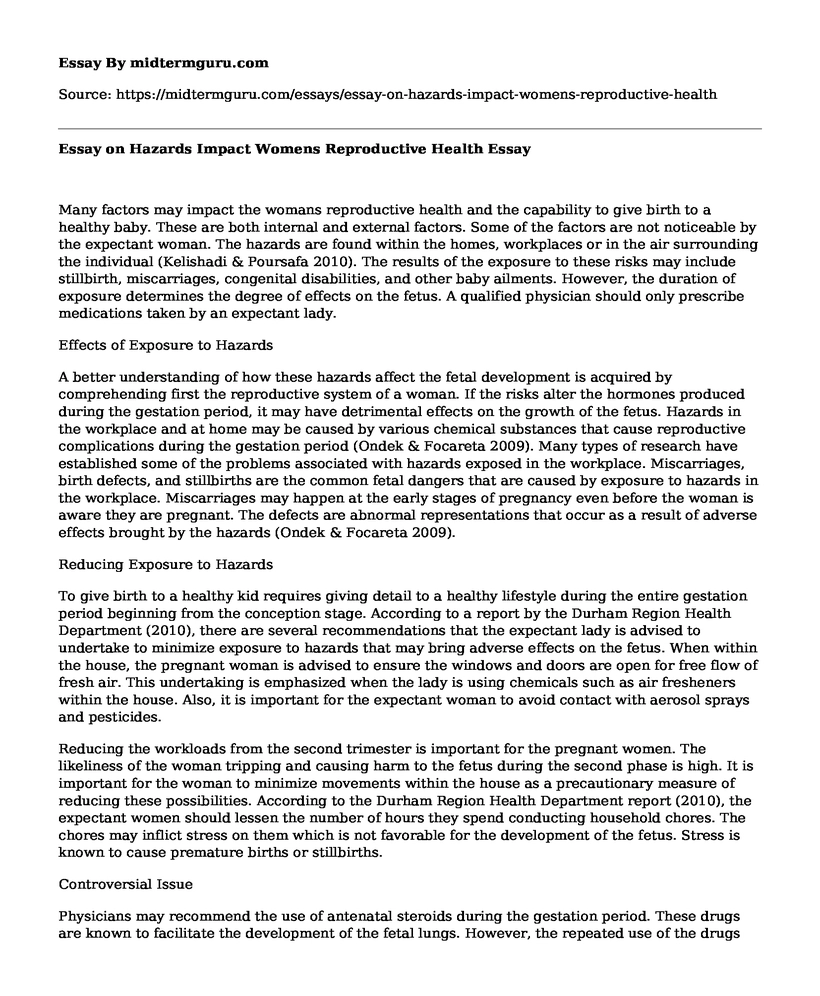Many factors may impact the womans reproductive health and the capability to give birth to a healthy baby. These are both internal and external factors. Some of the factors are not noticeable by the expectant woman. The hazards are found within the homes, workplaces or in the air surrounding the individual (Kelishadi & Poursafa 2010). The results of the exposure to these risks may include stillbirth, miscarriages, congenital disabilities, and other baby ailments. However, the duration of exposure determines the degree of effects on the fetus. A qualified physician should only prescribe medications taken by an expectant lady.
Effects of Exposure to Hazards
A better understanding of how these hazards affect the fetal development is acquired by comprehending first the reproductive system of a woman. If the risks alter the hormones produced during the gestation period, it may have detrimental effects on the growth of the fetus. Hazards in the workplace and at home may be caused by various chemical substances that cause reproductive complications during the gestation period (Ondek & Focareta 2009). Many types of research have established some of the problems associated with hazards exposed in the workplace. Miscarriages, birth defects, and stillbirths are the common fetal dangers that are caused by exposure to hazards in the workplace. Miscarriages may happen at the early stages of pregnancy even before the woman is aware they are pregnant. The defects are abnormal representations that occur as a result of adverse effects brought by the hazards (Ondek & Focareta 2009).
Reducing Exposure to Hazards
To give birth to a healthy kid requires giving detail to a healthy lifestyle during the entire gestation period beginning from the conception stage. According to a report by the Durham Region Health Department (2010), there are several recommendations that the expectant lady is advised to undertake to minimize exposure to hazards that may bring adverse effects on the fetus. When within the house, the pregnant woman is advised to ensure the windows and doors are open for free flow of fresh air. This undertaking is emphasized when the lady is using chemicals such as air fresheners within the house. Also, it is important for the expectant woman to avoid contact with aerosol sprays and pesticides.
Reducing the workloads from the second trimester is important for the pregnant women. The likeliness of the woman tripping and causing harm to the fetus during the second phase is high. It is important for the woman to minimize movements within the house as a precautionary measure of reducing these possibilities. According to the Durham Region Health Department report (2010), the expectant women should lessen the number of hours they spend conducting household chores. The chores may inflict stress on them which is not favorable for the development of the fetus. Stress is known to cause premature births or stillbirths.
Controversial Issue
Physicians may recommend the use of antenatal steroids during the gestation period. These drugs are known to facilitate the development of the fetal lungs. However, the repeated use of the drugs may result in undesirable traits on the fetus (Lamer 2002). The steroids have chemicals that increase the exposure of the fetus to hazards. There are emerging conflicts between healthcare facilitators across the world. The perceived benefits and risks of the antenatal drugs are yet to be agreed by the various clinical platforms.
Need for Further Research
Future studies should focus on addressing the controversies surrounding the issue of fetal hazards. Many kinds of research have been conducted to establish the risks and how to reduce them. However, the emerging controversies have a limited range of literature.
References
Durham Region Health Department Report. (2010). Environmental Hazards in PregnancyAccessed on 08 December 2016 Retrieved From:
http://www.durham.ca/departments/health/family_health/parenting/pregnancy/enviroHazard.pdf
Kelishadi, R., & Poursafa, P. (2010). Air pollution and non-respiratory health hazards forchildren. Arch Med Sci, 6(4), 483-95.
Lamer, P. (2002). Current controversies surrounding the use of repeated courses of antenatalsteroids. Advances in Neonatal Care, 2(6), 290-303.
Ondek, M., & Focareta, J. (2009). Environmental hazards education for childbirth educators. Journal of Perinatal Education.
Cite this page
Essay on Hazards Impact Womens Reproductive Health. (2021, May 26). Retrieved from https://midtermguru.com/essays/essay-on-hazards-impact-womens-reproductive-health
If you are the original author of this essay and no longer wish to have it published on the midtermguru.com website, please click below to request its removal:
- Essay on Concern for Environmental Justice
- Questions and Answers on Human Factors and Errors in Public Health - Paper Example
- Essay Sample on Education and Living A Healthier Lifestyle
- Essay Sample on Conspiracy Theories: Do Vaccines Cause Autism?
- Professional Nurses: Professional Standards & Performance Evaluation - Essay Sample
- Unprecedented Global Diabetes Crisis: Urgent Action Needed - Research Paper
- Special Education: Supporting Inclusivity for All - Research Paper







